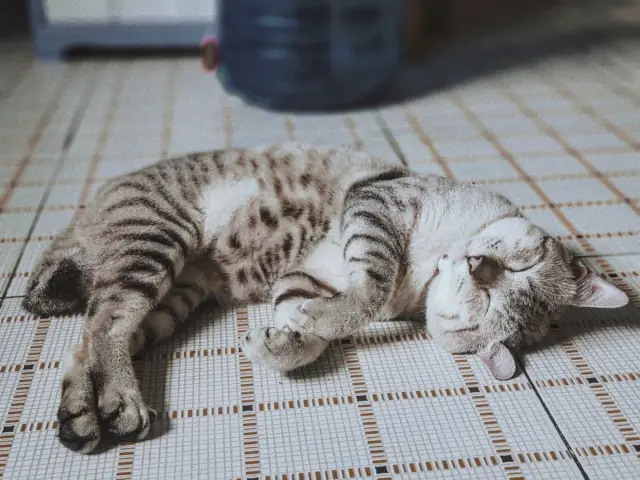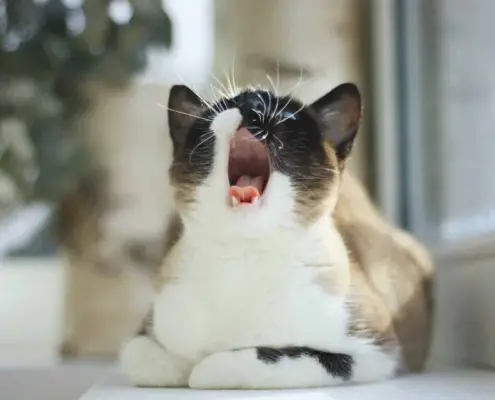
Cats are known for their independent and mysterious nature, and their sleep behavior is no exception. If you’ve ever observed a sleeping cat, you may have wondered if they dream just like humans do. In this article, we will delve into the fascinating world of feline sleep behavior and explore the question: do cats dream?
Understanding sleep cycles in cats
To understand whether cats dream, it is important to first understand their sleep cycles. Cats, like humans, go through different stages of sleep. They have two primary sleep states: non-rapid eye movement (NREM) sleep and rapid eye movement (REM) sleep.
During NREM sleep, cats experience deep relaxation and restfulness. Their breathing and heart rate slow down, and their muscles relax. This is the time when cats are in a state of deep sleep and are less likely to be disturbed.
REM sleep, on the other hand, is the stage where dreaming occurs. In this state, cats may exhibit rapid eye movements and twitching. This is also the stage where most of their memorable dreams take place.
Do cats dream? The scientific debate
The question of whether cats dream has been the subject of scientific debate for many years. While it is challenging to directly measure and interpret feline dreams, several studies suggest that cats do indeed dream.
One study conducted by researchers at the Massachusetts Institute of Technology (MIT) found that cats exhibit similar brain wave patterns during REM sleep as humans do when they dream. This suggests that cats may experience dreams similar to those of humans.
However, other scientists argue that while cats may experience dreams, the content and nature of their dreams may be different from that of humans. Cats’ dreams may be more focused on their instinctual behaviors, such as hunting or territorial marking.
Signs that cats may be dreaming
While we may not be able to know for sure what cats dream about, there are some signs that indicate they may be dreaming. One common sign is twitching or jerking movements during sleep. This is often accompanied by rapid eye movements, similar to what humans experience during REM sleep.
You may also notice your cat making soft or muffled sounds while asleep. These sounds can range from chirping to meowing and may indicate that they are reacting to something in their dreams.
Another sign of feline dreaming is the occasional paw movement or kneading behavior. Cats often exhibit this behavior when they are in a state of deep relaxation or pleasure, which may be an indication that they are experiencing positive dreams.
The role of REM sleep in cat dreams
REM sleep, the stage where dreams occur, plays a crucial role in the overall sleep cycle of cats. It is during this stage that their brains are highly active, and their bodies are essentially paralyzed to prevent them from acting out their dreams.
Research suggests that REM sleep is essential for memory consolidation and learning in cats. It is also believed to play a role in emotional regulation and overall mental well-being. Therefore, dreaming during REM sleep may serve important functions in a cat’s cognitive and emotional development.
What cats may dream about
While we can’t know for certain what cats dream about, it is believed that their dreams are closely tied to their natural instincts and behaviors. Cats are known for their hunting prowess, so it is likely that their dreams involve scenarios related to stalking, chasing, and capturing prey.
In addition to hunting, cats may also dream about their daily experiences and interactions. This could include dreaming about their favorite toys, exploring their territory, or interacting with their human companions.
It is important to note that every cat is unique, and their dreams are likely influenced by their individual experiences and personality traits. Some cats may have more vivid dreams, while others may have more subtle dream experiences.
Factors that influence cat dreams
Several factors can influence a cat’s dreams. One important factor is their overall health and well-being. Cats that are in good physical and mental condition are more likely to have positive and enriching dream experiences.
Environmental factors also play a role in cat dreams. Providing a comfortable and safe sleep environment can enhance a cat’s sleep quality and potentially improve their dream experiences. Soft bedding, a quiet atmosphere, and a familiar sleeping spot can all contribute to a sleep-friendly environment for cats.
Lastly, a cat’s daily experiences and interactions can influence their dreams. Positive and stimulating experiences during waking hours can contribute to more positive dream scenarios. Similarly, stressful or negative experiences may result in more unsettling dream experiences.
Common sleep behaviors in cats
While dreaming is an intriguing aspect of feline sleep behavior, there are also other common sleep behaviors that cats exhibit. Cats are known for their ability to sleep for long periods throughout the day. On average, cats sleep for around 12-16 hours a day.
Cats often display a preference for cozy and elevated sleeping spots. They may choose to sleep on windowsills, perches, or even on top of furniture. This behavior is rooted in their instinctual need for security and a vantage point from which to observe their surroundings.
Another common sleep behavior in cats is the “cat nap.” Cats have the ability to enter a light sleep state where they can quickly awaken if necessary. This allows them to conserve energy while remaining alert to potential threats.
How to create a sleep-friendly environment for cats
Creating a sleep-friendly environment for your cat is essential for their overall well-being and happiness. Here are some tips to help you create an environment that promotes restful sleep and potentially enhances their dream experiences:
- Provide a comfortable and cozy bed or sleeping spot for your cat. Choose bedding that is soft and supportive, and make sure it is placed in a quiet and secure area of your home.
- Consider providing a cat tree or perch where your cat can observe their surroundings. This will not only give them a sense of security but also a vantage point from which they can engage in their natural instinct of watching over their territory.
- Establish a consistent sleep routine for your cat. Cats thrive on routine, so try to feed them and play with them at regular times each day. This will help signal to their internal clock when it’s time to sleep.
- Create a calm and peaceful sleep environment. Avoid loud noises or sudden disruptions that may startle your cat out of their sleep. Providing a quiet and peaceful atmosphere will promote uninterrupted sleep and potentially enhance their dream experiences.
The mysterious world of feline dreams
In conclusion, cats do dream, and their dreams are likely influenced by their natural instincts and daily experiences. While we may never know exactly what they dream about, the signs of twitching, rapid eye movements, and soft vocalizations suggest that they experience vivid dream states during REM sleep.
Creating a sleep-friendly environment for your cat can enhance their sleep quality and potentially improve their dream experiences. By providing a comfortable bed, a secure sleeping spot, and a calm atmosphere, you can ensure that your feline friend has a restful and enriching sleep experience.
So, the next time you see your cat twitching or chirping while asleep, remember that they are likely embarking on a nocturnal adventure in their dream world. Embrace the mystery and wonder of feline dreams, and let your cat’s night-time adventures unfold.
If you enjoyed my article, I would appreciate you sharing it with your network.

Sima Ndlebe
Sima writes for CatBuzz. He is interested in Cats, Health and Fitness, and Entrepreneurship.
Published: 17 November 2023



